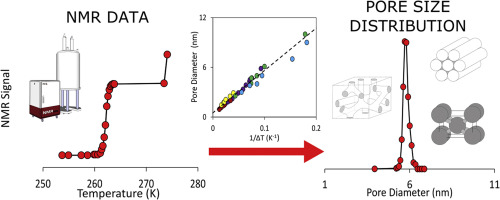Microporous and Mesoporous Materials ( IF 4.8 ) Pub Date : 2018-01-08 , DOI: 10.1016/j.micromeso.2018.01.004 Taylor J. Rottreau , Christopher M.A. Parlett , Adam F. Lee , Rob Evans

|
Nuclear magnetic resonance (NMR) cryoporometry is a non-invasive method for determining the pore size distributions of materials such as porous silica. Cryoporometry has several advantages over other porometric techniques. It is able to measure the melting process in a series of discrete steps, whereas transient heat flow techniques, such as differential scanning calorimetry (DSC), have a minimum rate of measurement, and, secondly, NMR cryoporometry can analyze pore shapes with any geometry, where nitrogen porosimetry is complicated for samples with spherical pores with narrow necks. However, one key drawback of the method is that, for any one liquid observed in any one material, there is a lack of consensus in the two parameters, and , used to convert experimental NMR melting point depression data into a pore size distribution. By considering two decades worth of literature data, values for both were obtained for water in porous silica supports, in particular an estimate of a non-freezing layer between the solid ice and the inner surface of the pore. These values were used to produce pore size distributions for three silica materials, SBA-15 and KIT-6, both with cylindrical pores but possessing different structures, and SBA-16, which has spherical pores. This represents the first time KIT-6 has been characterized by the NMR method. Furthermore, this work demonstrates a general method for obtaining values for and which can be applied to any liquid for which suitable literature data is available.
中文翻译:

多孔二氧化硅的NMR低温计量法:测定探针液体的熔点降低参数的方法
核磁共振(NMR)低温法是一种非侵入性方法,用于确定材料(例如多孔二氧化硅)的孔径分布。低温计量法比其他孔隙计量技术具有多个优势。它能够通过一系列不连续的步骤来测量熔融过程,而瞬态热流技术(例如差示扫描量热法(DSC))具有最小的测量速率,其次,NMR低温法可以分析任何几何形状的孔形,对于具有狭窄颈部球形孔的样品,氮孔隙率法很复杂。但是,该方法的一个主要缺点是,对于在任何一种材料中观察到的任何一种液体,这两个参数都缺乏共识, 和,用于将实验NMR熔点降低数据转换为孔径分布。通过考虑几十年的文献数据,获得了多孔二氧化硅载体中水的两个值,特别是固体冰和孔内表面之间的非冻结层的估计值。这些值用于产生三种二氧化硅材料的孔径分布,SBA-15和KIT-6均具有圆柱孔但具有不同的结构,而SBA-16具有球形孔。这代表首次通过NMR方法对KIT-6进行了表征。此外,这项工作演示了一种获取值的通用方法 和 可以应用于可获得适当文献数据的任何液体。











































 京公网安备 11010802027423号
京公网安备 11010802027423号